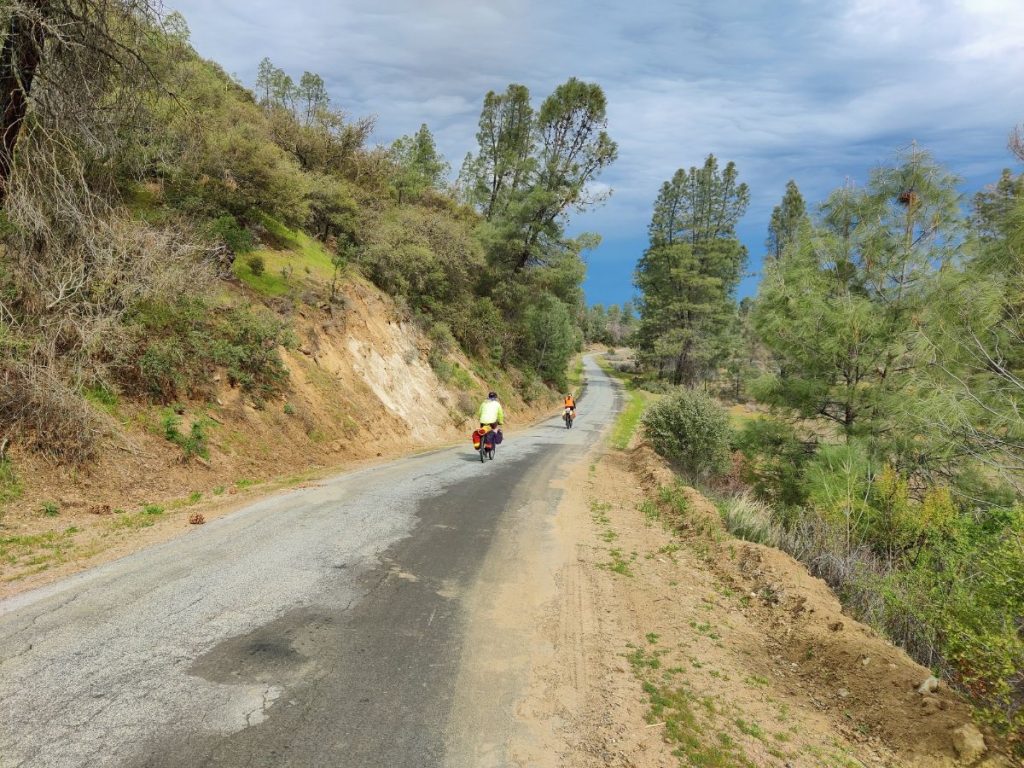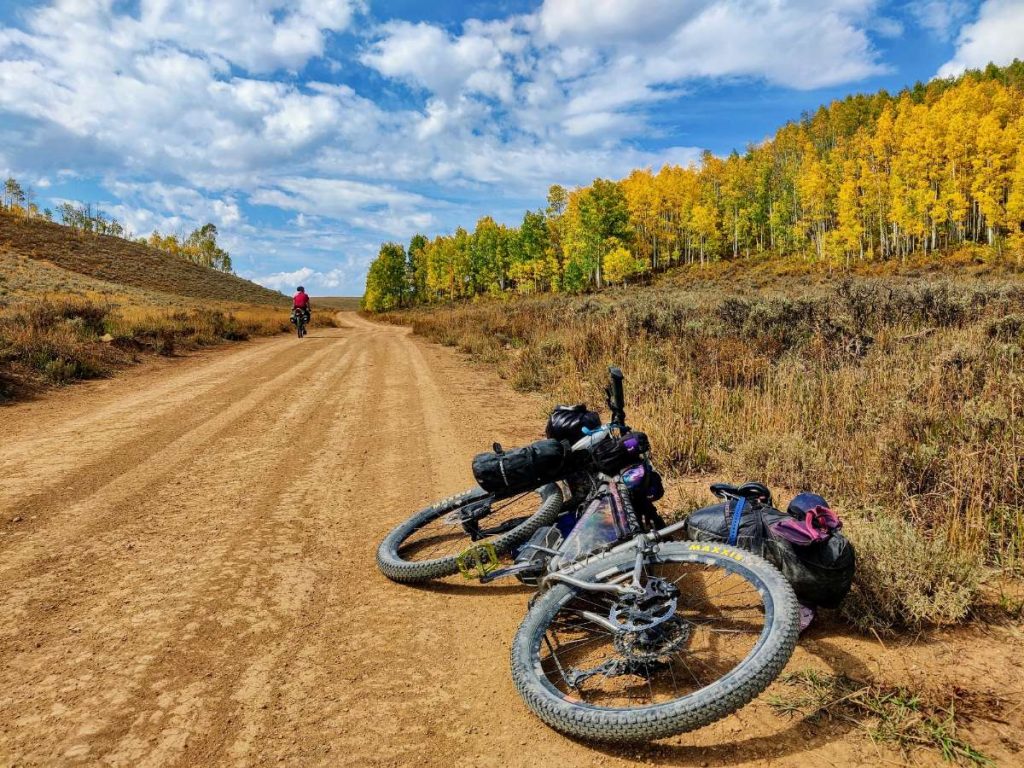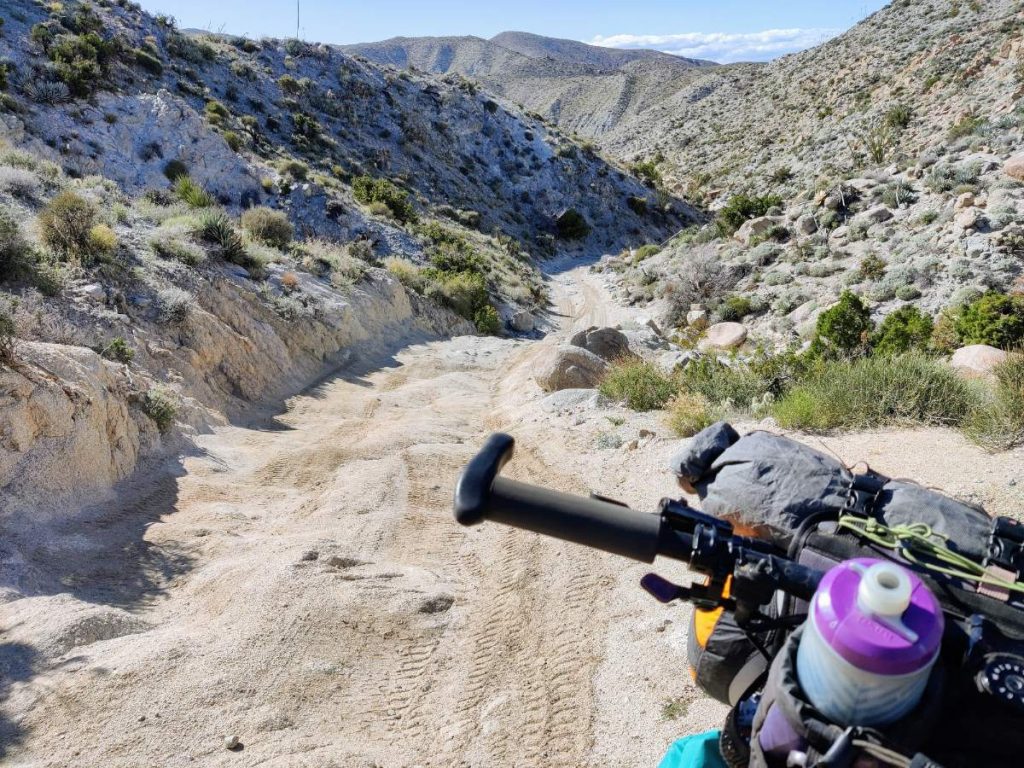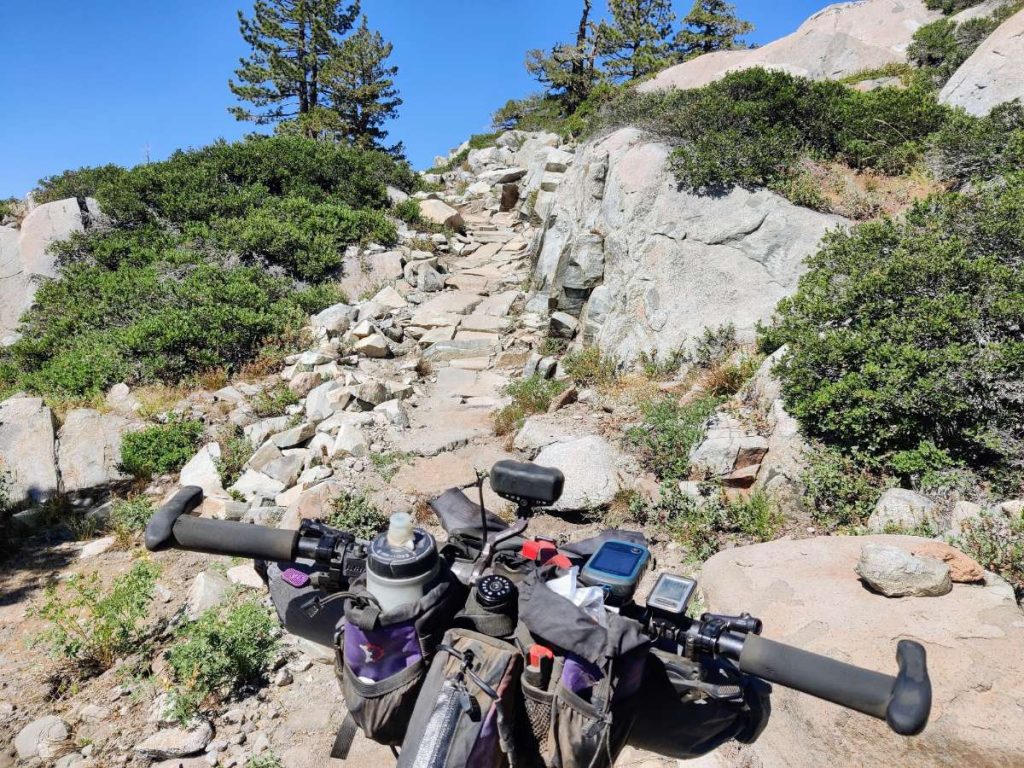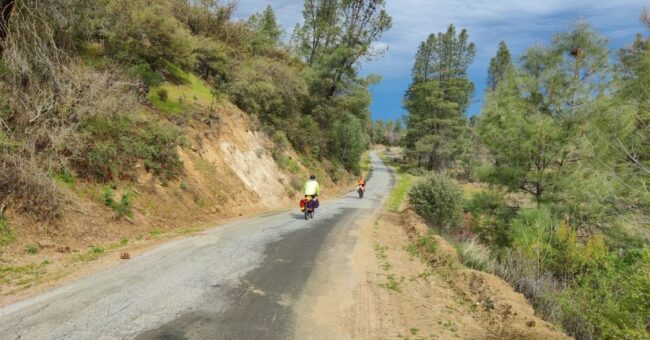
Imagine you’re planning your dream ride, whether it’s the Great Divide or a long weekend. The key question most of us need to answer first is: How long will it take? Once we know this we can plan everything else: time off work, food supply, transportation, etc.
The tricky thing about bikepacking is that pace varies widely based on so many factors.
Riders have different fitness levels, gear weights, and bike choices.
Terrain varies from smooth and chill to heinous hike-a-bike.
One person bikepacks for the scenic photo breaks and leisurely afternoons at camp, while another enjoys pushing to see how far they can get each day.
All of this is bikepacking! But a route that takes one person 5 days could take someone else 10 days, and each will be unhappy trying to match the other’s pace.
So how long will a route take YOU to finish?
To help, I built this bikepacking pace calculator to walk you through these factors and how they’ll affect your ride. Try it out with one of the pre-filled example routes like the GDMBR, or enter your own route details to plan your next trip!
Notes About the Calculator
Now that you’ve had a chance to try it out, read on to learn how the model works and what to pay attention to when estimating your bikepacking pace.
Averages Only!
First, a warning: This tool works with averages over the entire route. On a long and varied ride you should expect daily distance, climb, speed, and riding time to vary quite a bit!
Some days the terrain, weather, and your body will conspire and you’ll ride a laughably short distance. Just 10 miles can be plenty! Other days the wind will be at your back (literally and figuratively) and you’ll surprise yourself with a new personal best.
So take everything here with a grain of salt, play around with the settings to understand their effect, and stay flexible once you’re out on the road or trail.
Route Basics (Distance and Climb)
To kick things off, enter basic stats about your route: total distance and total elevation gain. You can use either miles / feet or metric units (American here, trying my best to include the rest of the world).
Don’t have a specific route in mind yet? Tap one of the example routes at the top to auto-fill this section and the one below it.
These number are used by the model in two ways:
Total distance: Used to calculate total days needed to ride the route. Also used to calculate average elevation gain per unit distance, which is used to scale riding speeds a bit slower on hillier routes.
Total elevation gain: Used to calculate average elevation gain per day, and also to scale riding speeds a bit slower on hillier routes.
Terrain Breakdown
One person’s bikepacking is smooth gravel roads while another’s is technical singletrack. Naturally their paces will be very different!
This section lets you define the terrain breakdown for your route. The model uses these numbers to estimate average riding speed over the whole route as a weighted average, with more rugged terrain obviously being slower.
These percentages don’t have to be exact, just take your best guess. Do make sure they add up to 100%. Here are the options:
Pavement: Paved roads of varying quality, or anything that rides similarly (smooth hardpacked dirt for example).
Gravel: Maintained unpaved roads (or bike paths or doubletrack) made of gravel or dirt.
Rough 4×4 tracks, easy singletrack: Slower terrain unsuitable for most vehicles.
Technical singletrack: Rugged trail requiring technical riding skills and often a fair amount of hike a bike.
Here are some visual examples:
Your Riding Speed
This is a rough estimate of your pedaling speed when the bike is moving. Breaks not included!
Most of us don’t actually know our precise moving speed while bikepacking, and it varies hugely depending on terrain. That’s why this section uses a slider with general categories instead of a specific number.
Speeds corresponding to your chosen category are shown below the slider, and these are what the model uses for calculations. Don’t scoff at the low numbers! If you have a pace in mind from unloaded day rides, your bikepacking pace will be much slower.
When choosing your speed category consider all of the following:
- Your strength and fitness, meaning how quickly you can move the bike forward. Note that endurance (how many hours a day you can ride for) doesn’t factor in here; that’ll be in the next section.
- The weight of your gear and bike. A lightweight setup can bump a weaker rider up to a faster category, while a heavy setup can take a fit rider down a level.
- Your technical riding skills or lack thereof, if the route has rugged terrain.
- Your bike choice and how well it’s suited to the terrain. A mountain bike will be slower than average on road, likewise a road bike will be (much) slower than average on rugged dirt.
If you’ve input a total distance and elevation gain for your route, below the slider you’ll see speed numbers adjusted based on elevation gain per mile. The model applies a scaling factor that slows all terrain types when there is more climbing, but slows more rugged terrain types more than smooth ones.
This is for two reasons: 1) rugged terrain is more likely than smooth terrain to become hike-a-bike on steep uphills. And 2) you can’t make up as much time on the downhill when it’s rough and technical.
Off-Bike Time On Riding Days
This section is what really defines your bikepacking pace, even moreso than riding speed: how much time you’ll spend NOT riding.
It’s easy to forget that for most of us, most of our bikepacking time is spent NOT biking. All that time we spend sleeping, eating, enjoying camp, and even just snacking or running off behind the bushes for a pee break really adds up.
Each of us only gets 24 hours in a day, unfortunately! In this section you’ll enter how much time you want to spend off the bike, and it will calculate the amount of riding time you have left in a day.
Camp time: This is how much awake time you want to spend at camp each day. Include camp chores (pitching the tent, filtering water, washing up, cooking meals) as well as leisure time to rest or hang out. This time can be in daylight or darkness depending on the timing. In my opinion a relaxed ride needs at least two hours in the morning and two more in the evening.
Break time: Heads up, this one should be more than you think! Break time includes all time between camps not spent pedaling. Include lunch and snacks but also bathroom breaks, layer changes, map checks, picture taking, regrouping, resupplying, and any other general faffing and dawdling. It adds up fast!
Sleep time: Time spent in your shelter either sleeping or trying to sleep. I like a good 9 hours on a normal trip, but when bikepack racing I might go as low as 2 or 3 hours.
Daily Limits
Say the previous section calculated 9 hours of pedaling time after accounting for breaks and time at camp. Great! Surely that’s enough time to make quick work of a challenging route?
Not so fast (literally)… Many people don’t realize that this much actual pedaling time is a lot! Unless you’re quite fit and have great endurance, you’ll probably run out of energy before you run out of pedaling time.
This is especially common on strenuous routes with long daylight hours. I remember when bikepacking the Carretera Austral during far-south summer, our legs would be cooked hours before the waning daylight suggested it was time to camp.
So this section lets you set a daily limit on how much you want to ride. Here are the options:
None: No limit, set your desired break and camp times and plan to pedal for all remaining hours. Helpful for times and places with short daylight hours, or ambitious riders or racers wanting to maximize forward progress.
Pedaling hours per day: Use this to limit riding hours to less than the number calculated in the previous section. This is a common way to limit long days on routes without too much elevation gain, especially if you’re experiencing any saddle discomfort. Sometimes you just don’t want to sit on the bike any longer, even if your legs still have strength.
Climb per day: On routes with a lot of elevation gain, many riders max out at a certain amount of climb regardless of mileage. Our legs just say “Nope! Camp time! Try again tomorrow.” A beginner’s max number might be somewhere around 2000 feet per day, while a more experienced rider can do 4000 feet per day. Folks with good endurance and willingness to ride many hours a day can do much more.
Distance per day: As explained above, most people find hours or climb to be a more intuitive limiting factor than distance. But this setting can be useful if camp locations are limited and spaced on average a certain distance apart.
Zero Days
A zero day, also called a rest day or a town day, is any day you make zero forward progress on your route.
Zero days can be planned strategically, like a side trip or day off to rest and refuel in a small town. They can also be unplanned due to weather, illness, mechanical issues, or a serendipitous chance to hang out with new friends you’ve met along the way.
Short trips usually don’t require rest days, but I like to take at least one on any trip longer than a week.
On longer trips I average about one zero day per week. Sometimes I’ll space them out further and then take two at once in a place I want to explore. Nothing like a luxurious “double zero” to reset both mind and body for the miles ahead!
What do you think?
This tool is currently a “rough draft” with room for improvement, so tell me what you think! Are the estimates accurate based on your experience? Any features you’d like to see?
Did you like this new interactive format in general? Would you like me to build more planning tools for gear, food, water, etc?
Let me know in the comments below or on the Contact page.
More Bikepacking Resources
If you liked this post you might also like:
- 10 Spectacular Alpine Bikepacking Routes for Summer
- Are Dynamo Hubs Worth The Money?
- Bikepacking Abroad: Common Questions Answered
Or visit the bikepacking home page for lots more!
Bikepacking repair and supply kits – new batches ready! Designed on the trail and assembled in my living room to save you money, space, and time.


Bike resources in your inbox?
There’s more where this came from! Sign up here for occasional emails full of inspiration and information about bikepacking and bicycle touring.


The post Bikepacking Pace Calculator: How Long Will Your Route Take? (interactive tool) appeared first on Exploring Wild.
